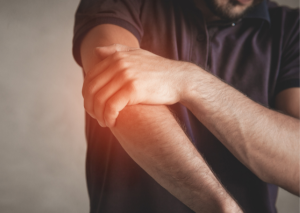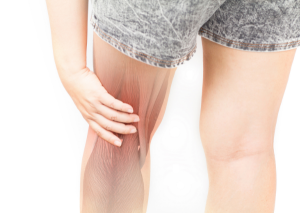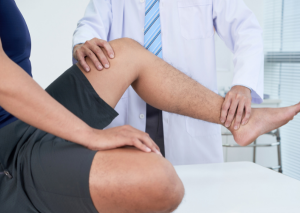Arm and Leg Pain

Do you experience pain, numbness, or discomfort in the arms and legs? Do you have arm and leg pain that doesn’t go away?
Our shoulder and hip joints are the most commonly used joints in our bodies and can be susceptible to many injuries. Many people don’t realize the source of their arm and leg pain.
If your arm and leg pain hasn’t improved, it might be time for you to consult a medical professional to provide pain relief. At Vascular & Interventional Specialists (VISP), we understand that experiencing any type of pain in your body can greatly impact your daily life and wellbeing.
Arm and leg pain is a common ailment that many people experience due to various conditions. We offer many procedures and treatment options to get you back to living again!
With Your Arm or Leg Pain, Do Your Symptoms Include the Following?

- Redness
- Swelling
- Stiffness
- Tingling
- Numbness
- Weakness
If your arm and leg pain patterns show any of these symptoms, consult a vascular specialist at VISP in Prescott, Arizona for a comprehensive physical examination of your shoulder and hip joints!
When to See a Doctor for Your Arm and Leg Pain

If you experience the symptoms above, you should go see a doctor right away. The doctor is going to decide how quickly the person needs to be seen based on age, the symptoms, and the presence of other medical conditions. Usually, a delay of a few days is not dangerous. Arm pain and leg pain usually do not indicate urgent issues.
Doctors usually ask about the symptoms of the person and the medical history. They might ask how intense the pain is and when the pain happens. Doctors then do a physical examination. Whatever they find from the symptoms and the person’s medical history will determine the tests that need to be done and the succeeding steps.
Let’s explore the possible causes of your symptoms and how we can help you.
What Would Cause Your Arms and Legs to Ache and What Treatments Are Available at VISP?
The less obvious reasons for arm and leg pain patterns can range from peripheral artery disease and diabetic neuropathy to sciatica and common electrolyte imbalances. Sometimes pain in the arms and legs could be caused by “referred pain” or pain that moves from one area of the body to another. This is true for a heart attack for example, where the pain goes to the arm.
The first step to pain relief is getting to the root cause of your leg or arm pain.
1. Arterial Disease
Peripheral Artery Disease (PAD) – Also known as Peripheral Vascular Disease (PVD), is the narrowing of one or more blood vessels in your legs, which leads to a decrease in blood circulation. Some physical symptoms associated with PAD may include:
- Activity-induced pain and cramping in your hip, thigh, or calf muscles
- Numbness
- Weakness
- Cold lower legs or feet, due to poor circulation
Heart Disease – This is the blockage, narrowing, or hardening (atherosclerosis) of the blood vessels that lead to the heart. The disease produces pain sensation that may be present in your arms, chest, and shoulders as part of other symptoms.
READ MORE ABOUT THE SYMPTOMS OF BLOCKED ARTERIES IN YOUR LEG
PROCEDURES AND TREATMENT FOR PAD/PVD AND HEART DISEASE
Peripheral Angiogram – This procedure is used to assess the severity of the narrowed artery caused by PAD. X-ray dye is inserted into the artery through a pencil tip-sized incision. Using real-time X-ray imaging, your interventional radiologist will be able to see where the blockage or obstruction is occurring. Once the problem artery is identified, treatment can usually occur at the same time using the following methods:
- Angioplasty – a small balloon is inserted into the blocked artery. Once placed, it is inflated to open or widen the obstructed artery to increase blood flow.
- Stent Placement – a stent is a small metal tube that is inserted into the artery to support an opened passageway for blood to flow.
- Atherectomy – is the removal of the plaque from the artery walls to help increase unrestricted blood flow.
A peripheral angiogram, along with the best-determined treatment, is performed in the Catheterization Laboratory as an outpatient procedure.
2. Vascular Issues
Venous Insufficiency – This condition is the insufficient blood flow from your leg veins to the heart caused by weak valves. These weakened valves do not shut properly causing blood to flow in the wrong direction. When the blood flows backward, it causes pooling and stretching of the veins, which create varicose veins. The excess pressure on the vein causes leg pain. Two veins commonly get affected by this condition:
- The great saphenous vein that runs down the inside of the thigh past the knee.
- The short saphenous vein that runs down the back of the calf below the knee.
Venous insufficiency is diagnosed by a special ultrasound which can be ordered during a consultation with our vein specialists.
Treatment of Painful Varicose Veins Include:
- Radiofrequency Vein Ablation – a procedure that uses radiofrequency energy to heat the vein and seal it closed. The body will naturally redirect the blood flow to healthy veins. This is an essentially pain-free minimally-invasive treatment performed as an outpatient procedure. You can expect quick pain relief and recovery time.
- Ambulatory Phlebectomy – the removal of the vein through tiny incisions in the leg.
- Injection Sclerotherapy – a method used to dissolve and shrink troublesome veins using an injected solution.
Schedule your consultation today
Another condition that causes leg pain is Deep Vein Thrombosis.
Deep Vein Thrombosis (DVT) – This is the formation of a blood clot in a vein in your thigh or leg causing pain and swelling. DVT can become life-threatening if not treated right away as the clot can become dislodged and travel to the lungs and cause a pulmonary embolism.
PROCEDURES AND TREATMENT FOR DVT
Inferior Vena Cava Filter (IVC) Placement – An IVC filter placement is used when other interventions have been unsuccessful, such as blood thinners, to dissolve a blood clot. An IVC filter is a small metal device inserted into the inferior vena cava to trap any clots, preventing them from traveling to your heart or lungs. As your vascular and interventional specialists, we will closely monitor the placement of your IVC. Once the risk for blood clots has been cleared we can schedule the IVC to be removed.
Deep Vein Thrombosis (DVT) Treatment – DVT Treatment is used if blood thinners or an IVC filter are no longer viable or effective treatment options. With the DVT treatment, your interventional radiologist will remove the clot directly from the vein.
LEARN MORE ABOUT TREATMENTS FOR DVT
3. Pinched Nerves

Arm or leg pain can also be a symptom of a pinched nerve. Pinched nerves can be caused by the narrowing of the spine (spinal stenosis), arthritis in the joints, or a herniated disc. These conditions cause pressure to be placed on the nerve. Impacted nerves are often associated with these common symptoms in the legs or arms:
- Pins and needles, or a tingling sensation
- Shooting or sharp pain
- A burning feeling
- Numbness
A pinched nerve in your Lumbar Spine may cause severe pain in the lower back and legs. Sciatica is also associated with an impacted nerve in this area, which causes shooting pain down your leg. A pinched nerve in your Cervical Spine can cause pain in your neck, shoulders, and arms.
TREATMENT FOR PINCHED NERVES AT VISP
We often treat arm or leg pain that is caused by a pinched nerve with our nerve block procedures. A nerve block will block the nervous system from sending pain signals to your brain. Nerve blocks are a proven method to provide pain relief in your arms and legs while helping to heal any nerve damage.
Nerve blocks are also very effective in treating chronic back pain that can coincide with arm or leg pain. The nerve block procedures we perform use a minimally invasive injection of anti-inflammatory medication directly to the site of pain.
We encourage you to call our office to set up a consultation with one of our specialists to see if you will benefit from a nerve block procedure. Other treatment options for pinched nerves we offer include:
- Selective Nerve Root Blocks
- Facet Injections
- Paraspinous Joint Injections
- Lumbar Epidural Steroid Injections
4. Bone Tumors
Bone tumors are less common in people than the aforementioned causes of arm or leg pain. Though, if you are experiencing any of the following symptoms, then having a conversation with one of our doctors would be advisable.
- Pain that comes and goes and gets worse at night
- Bones that are weak and easily fracture
- Swelling and tenderness
- Unexplained fatigue
- Unknown reason for weight loss
These situations usually lead to almost immediate pain or discomfort due to muscle and bone injury, as well as nervous system damage.
PROCEDURES WE OFFER FOR BONE TUMORS
Image-guided Biopsy – our highly-trained specialists use X-ray, ultrasound, CT, or MRI-guided imagery to locate the area in your bone that needs a biopsy. Once identified, your interventional radiologist will retrieve a sample of the tissue with little to no pain. This minimally invasive procedure only requires a small incision to gain access to the affected bone.
Mediport/Port-a-cath Placement – if you need ongoing medicated treatment, such as chemotherapy, we will place a Port-a-Cath or a Mediport device for easy medication administration.
LEARN MORE ABOUT OTHER PROCEDURES WE PROVIDE
Not All Arm or Leg Pain Is Related to a Serious Condition

More common causes of pain can be overuse or injury. If you are starting to notice discomfort in your limbs, try these home remedies first:
- Rest – the pain in your arm or leg may be caused by overuse. Ligaments and tendons can become inflamed and cause discomfort. Try limiting the use of the affected limb to see if the discomfort goes away.
- Ice – with inflammation, ice will help decrease any swelling.
- Elevate – elevate your arm or leg to help drain accumulated blood, which causes swelling.
- Over-the-Counter Pain-Reliever – NSAIDs like Ibuprofen, under the recommendation of your doctor, can help to decrease inflammation in your body and to relieve pain. Decreasing inflammation in your body can help it to heal.
- Physical Therapy Exercises and Stretches – gentle movements, strengthening exercises, and stretches can help to loosen tight muscles. Physical therapy is best when guided by a physical therapist who can provide the most beneficial movements to help strengthen and heal your body.
EXPLORE MORE HEALTH AND WELLNESS ARTICLES
Get the Relief You Need by Trusted Specialists

If you have tried these home remedies without getting relief, our specialists at VISP want to encourage you that there are other procedures and treatments. Do not let your symptoms go untreated, especially when they interfere with your daily living activities. Find relief with our highly-qualified and trained physicians at VISP.
